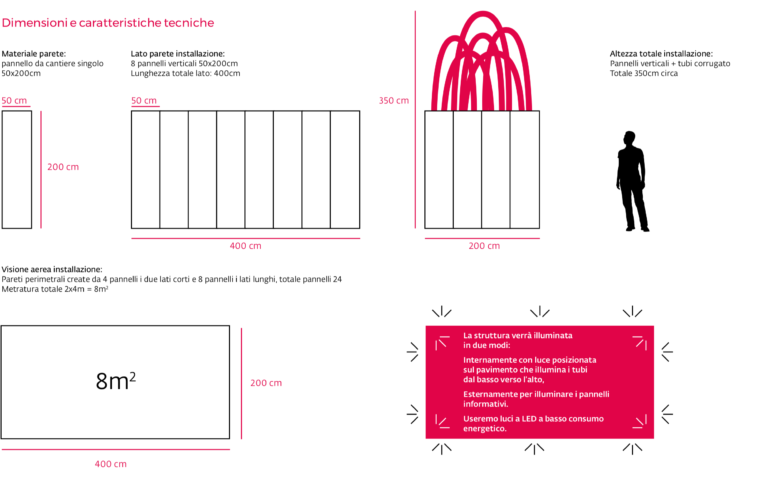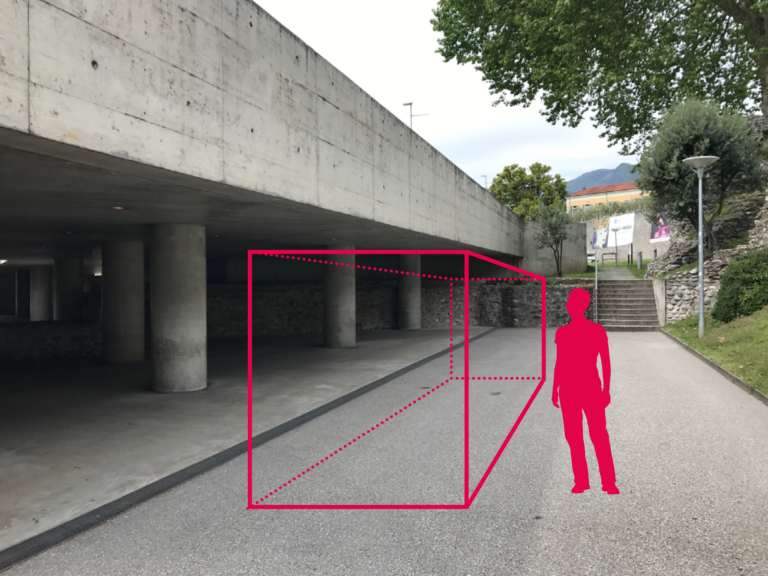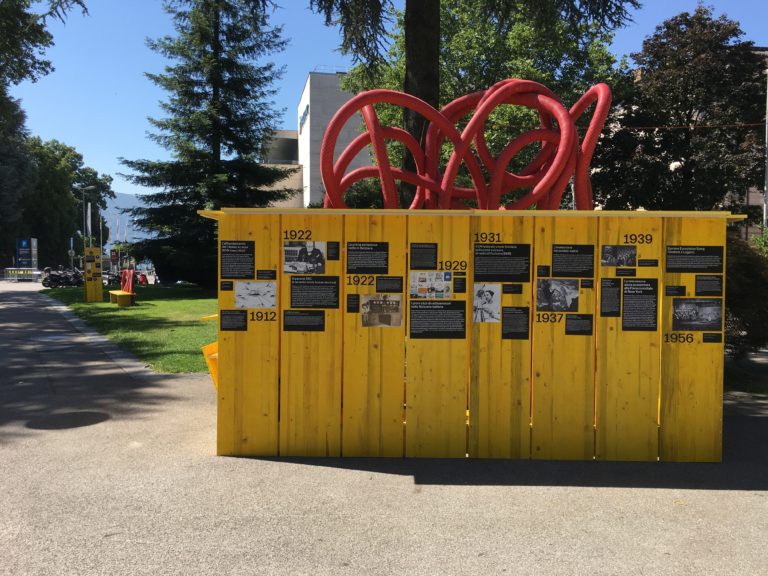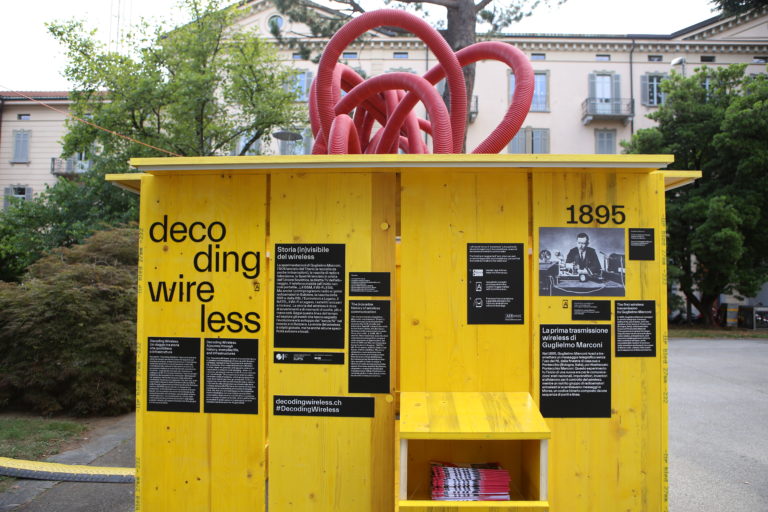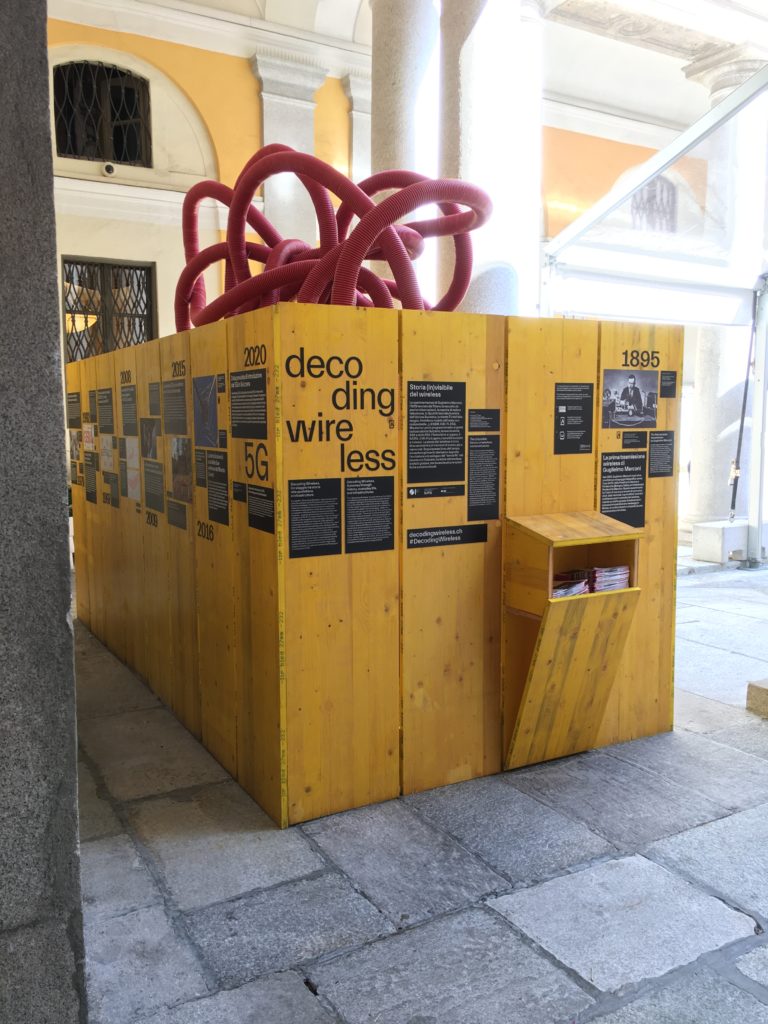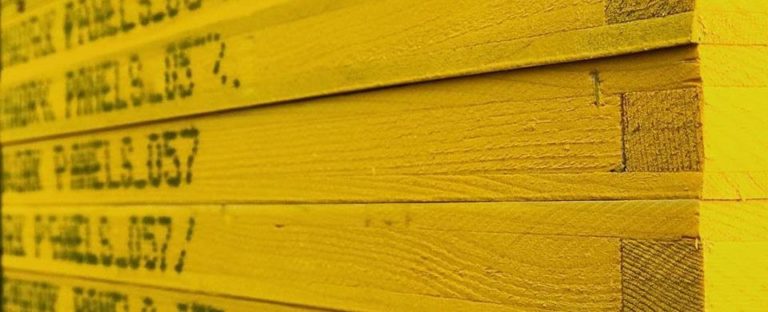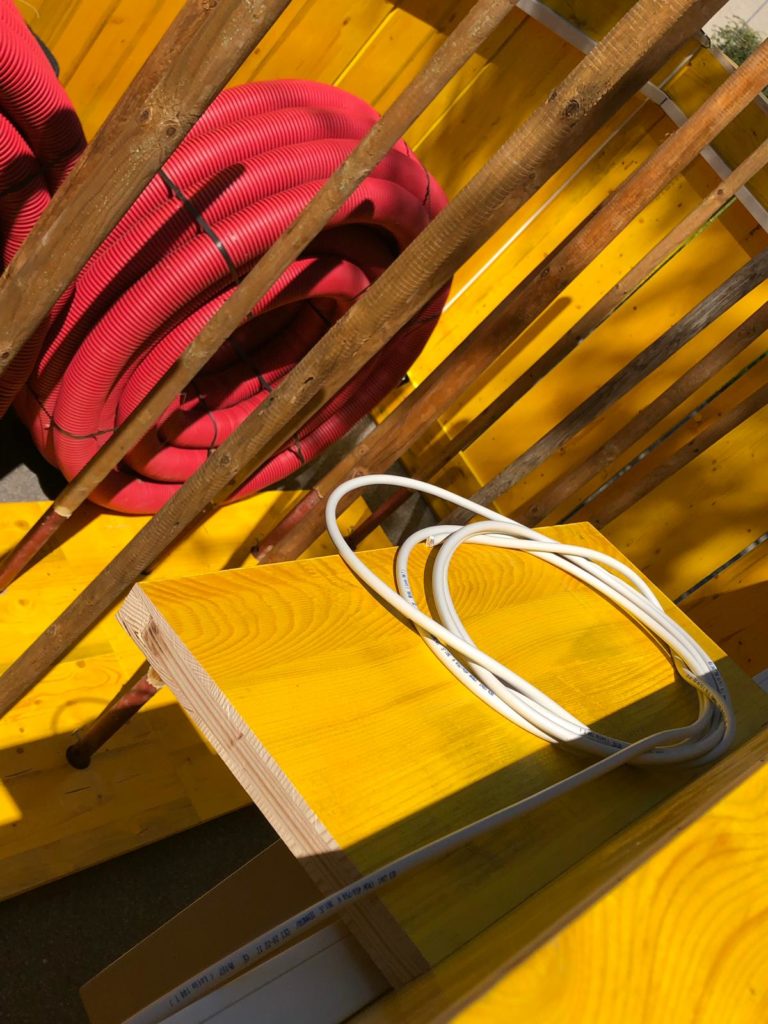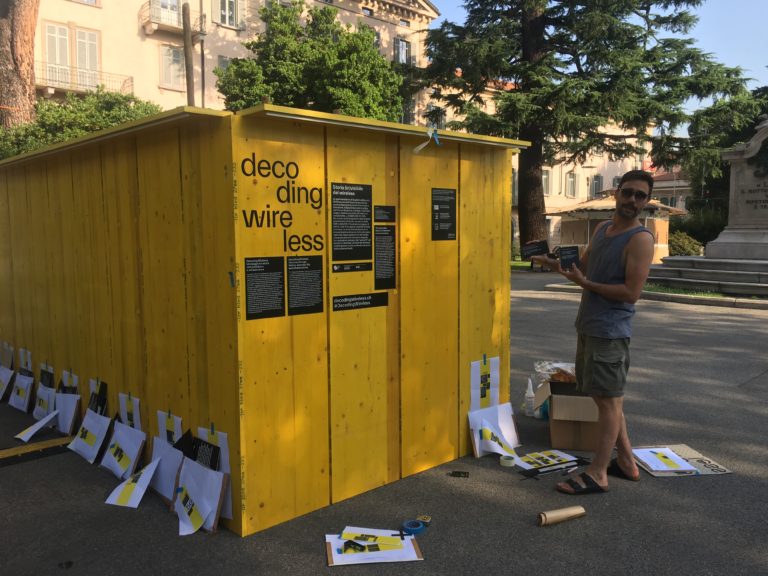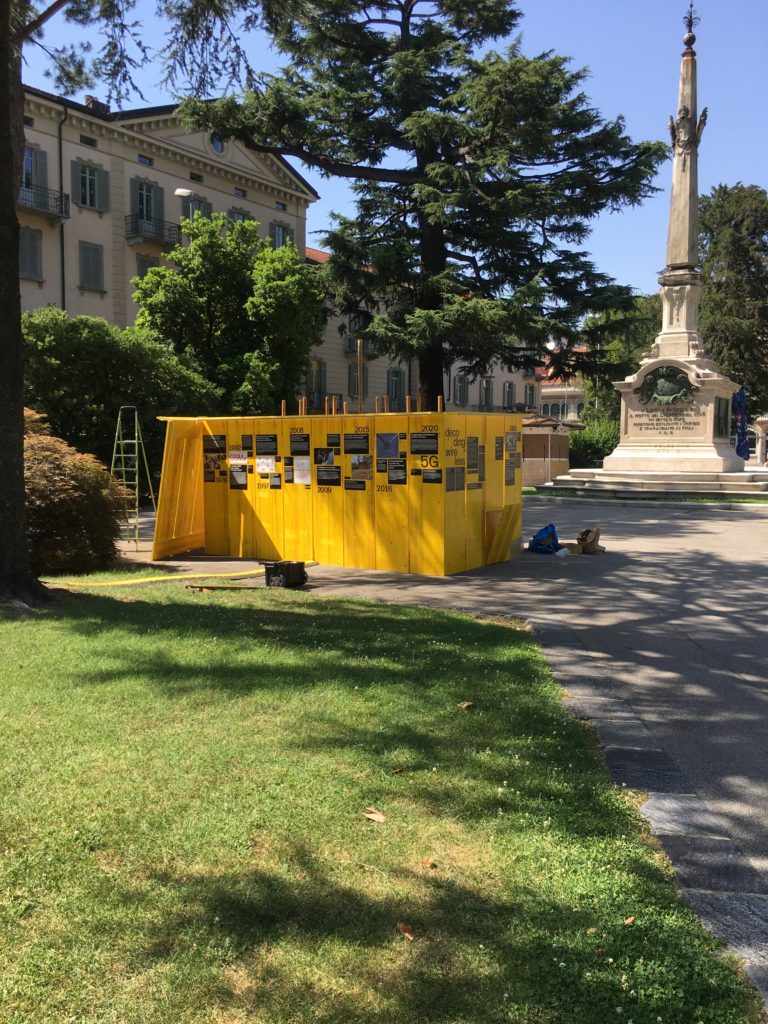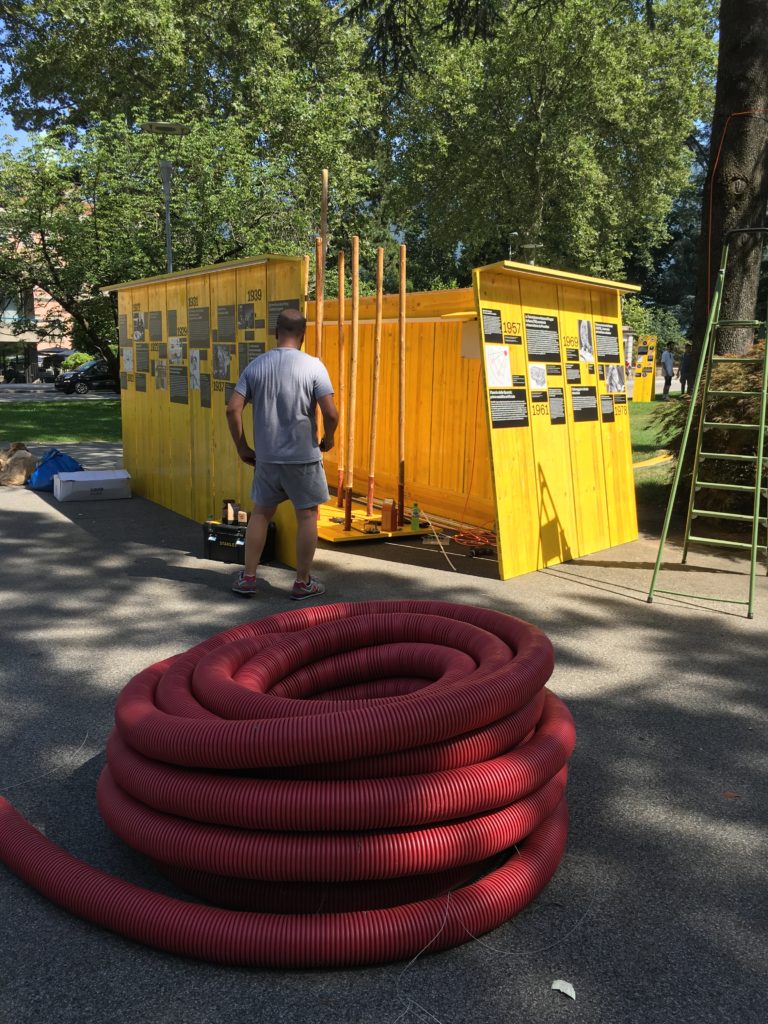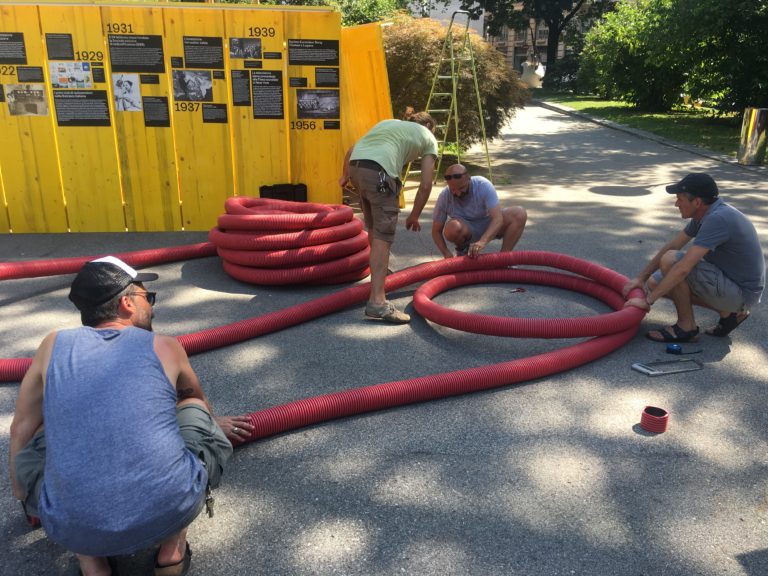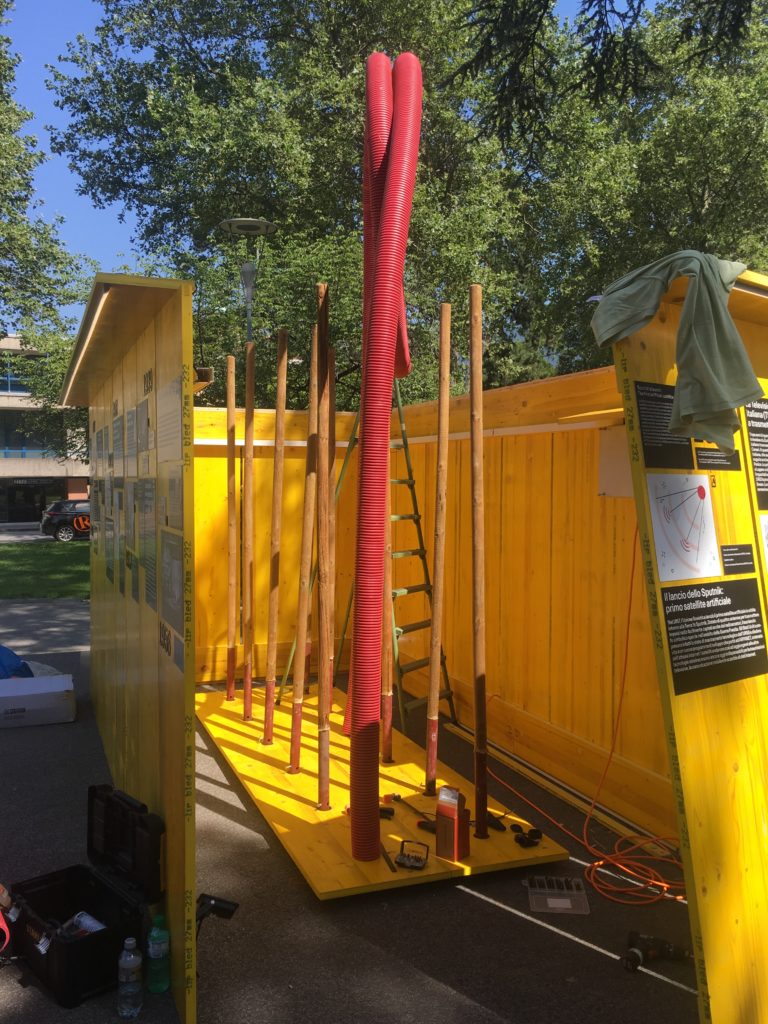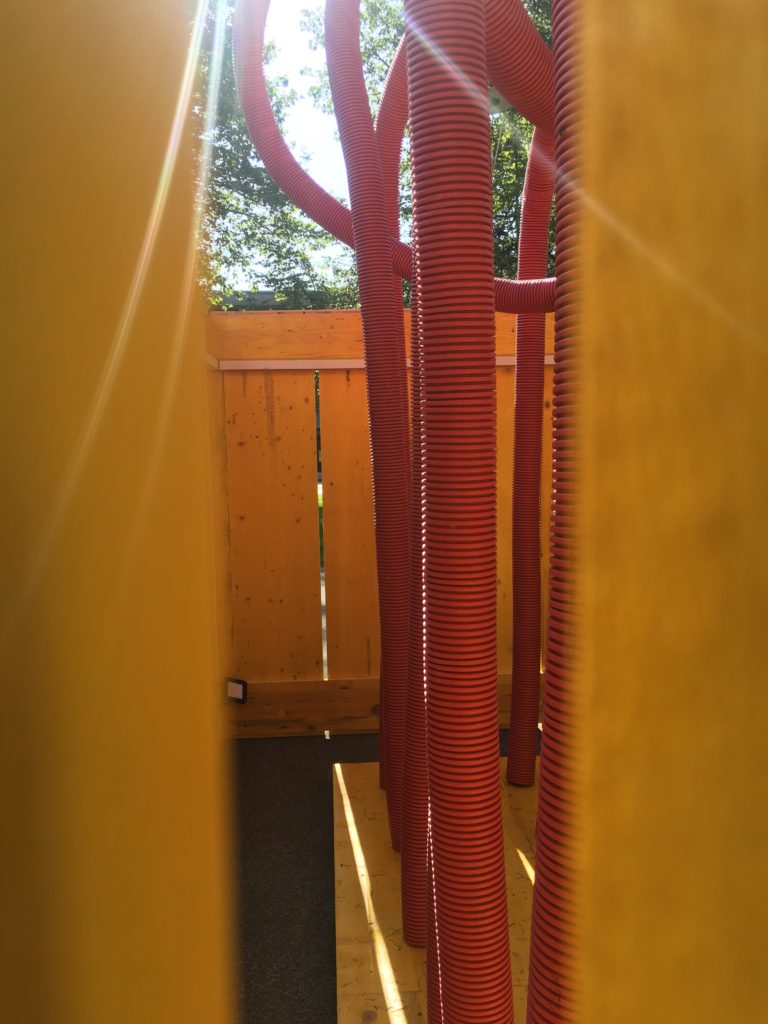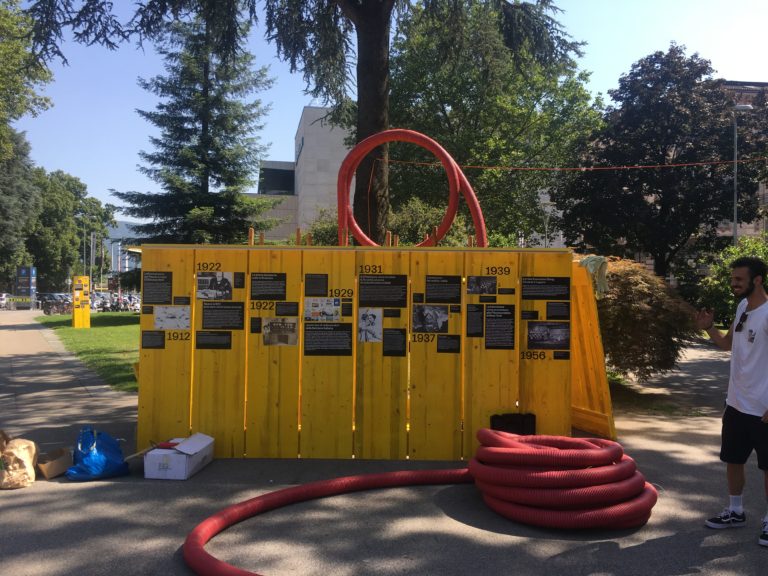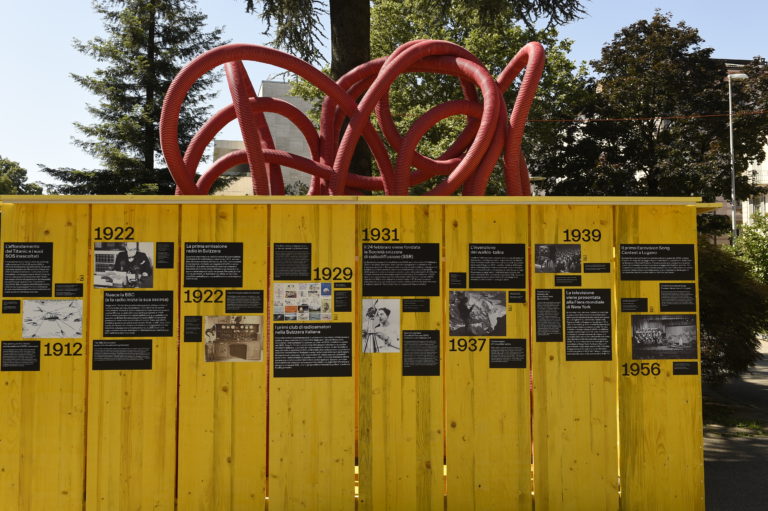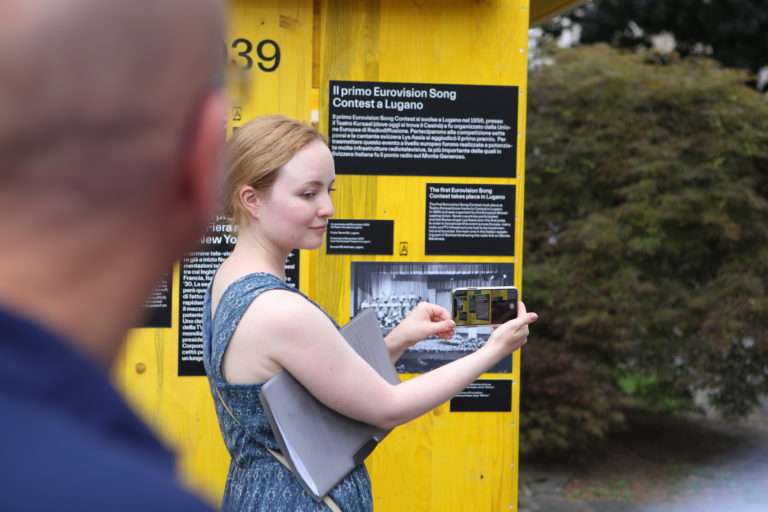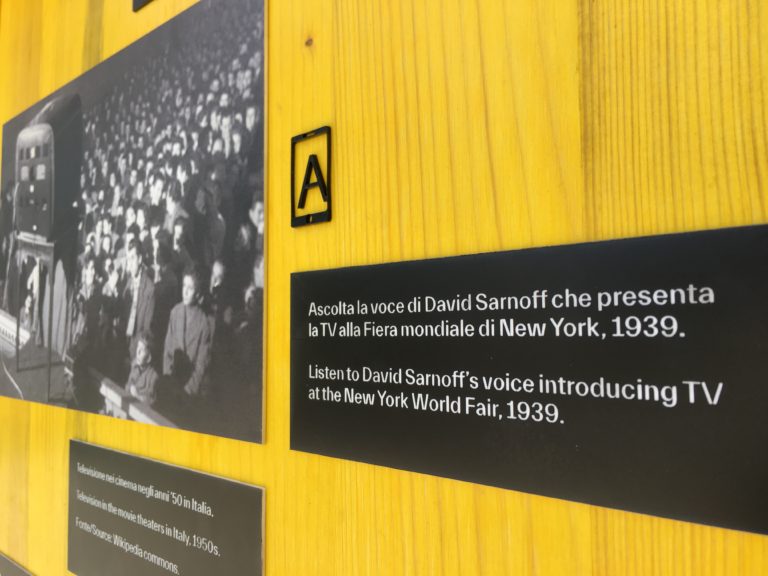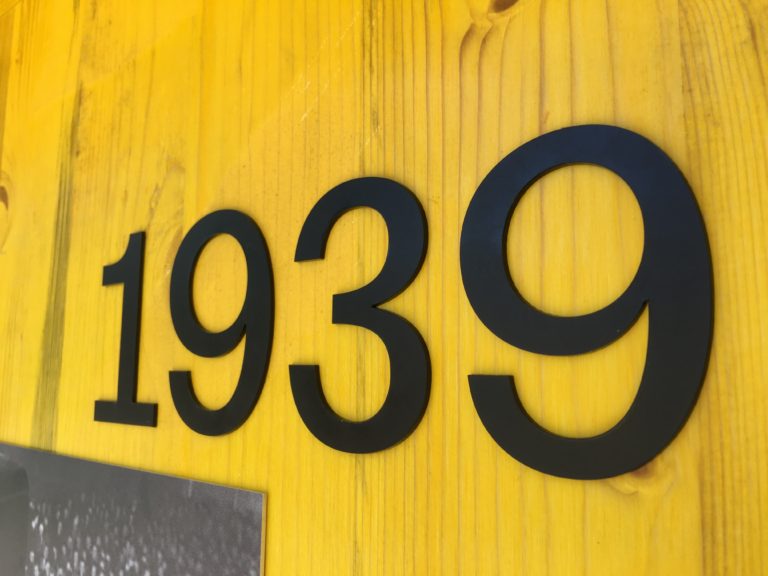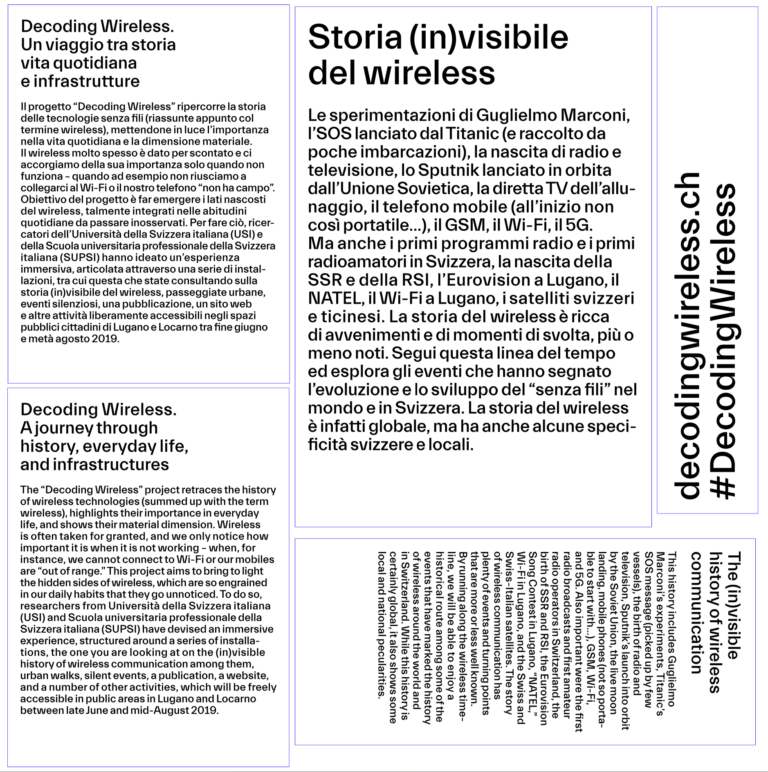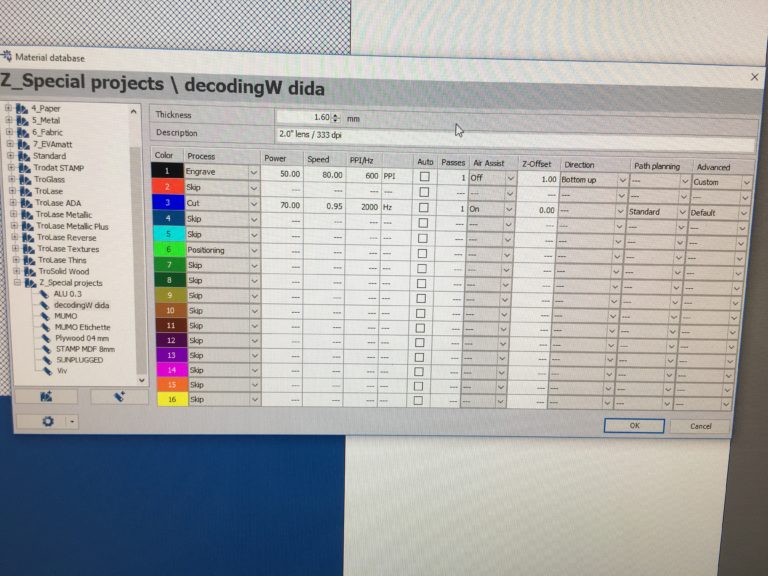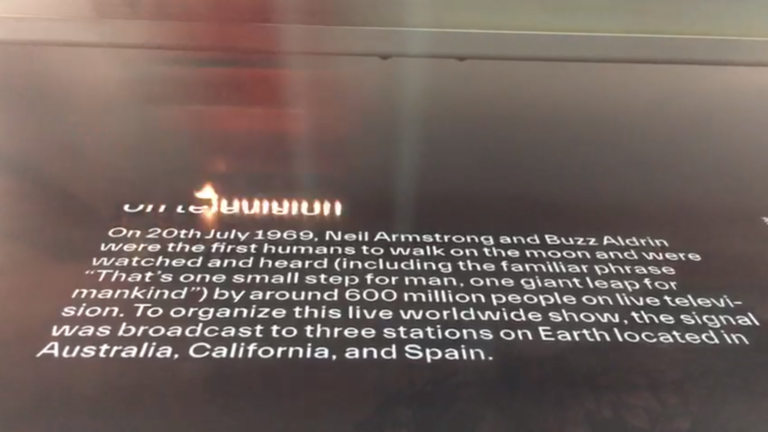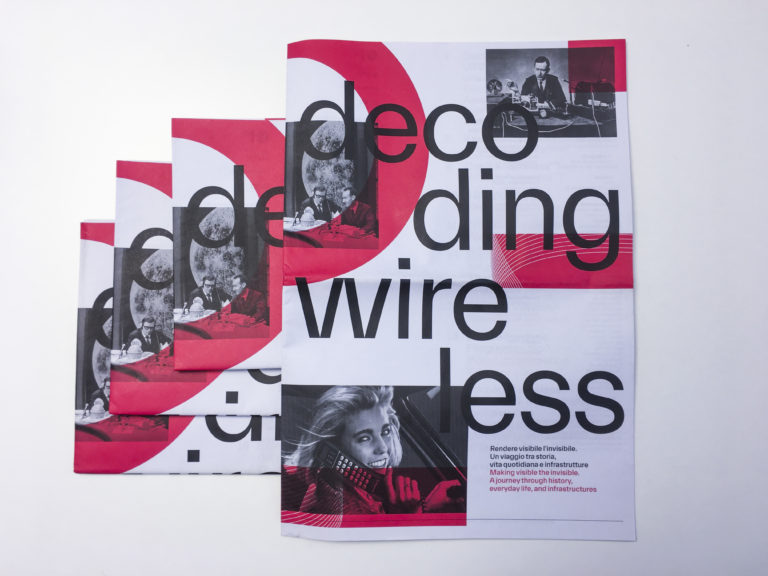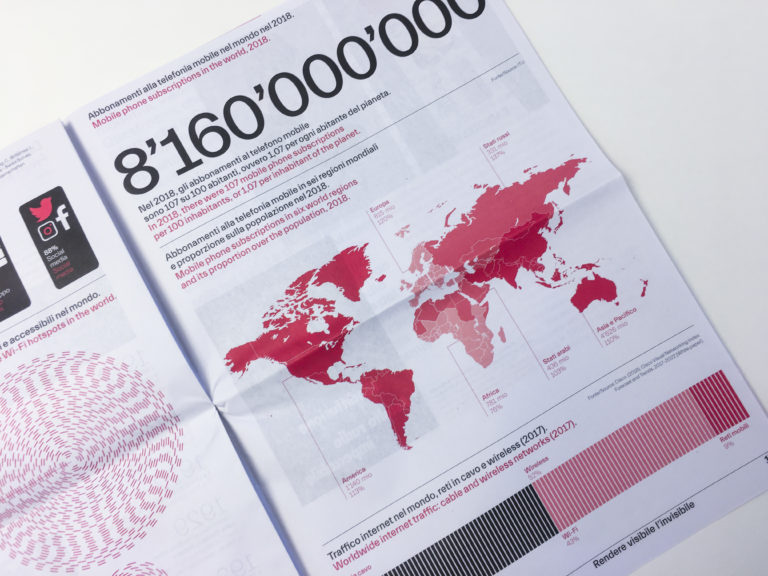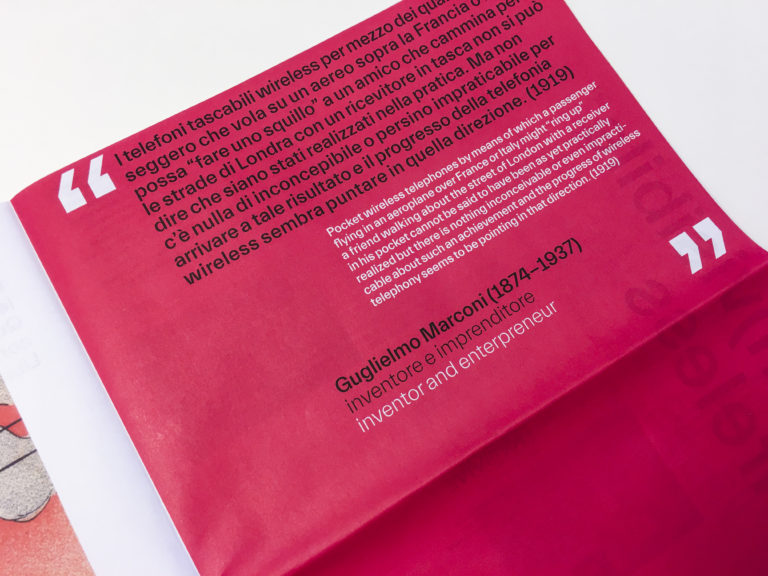
To retrace the history of wireless technologies, highlighting their importance in daily life and the material dimension,we created an installation that resembles a construction site, features a timeline with the history of wireless and includes a magazine for in-depth analysis.
Yard
To highlight the hidden material dimension of wireless and make visible a technology that seems invisible, we chose to depict a construction site with yellow panels and red tubes sprouting from the ground.
Setting-up
The installation consists of a parallelepiped of 2 meters by 4 meters, 2 meters high, without a base and a roof. The exhibition runs counterclockwise, from the first short side to the second long side. A container has been added to the structure to store the magazines for distribution. On the upper side and for the entire perimeter, a strip of LED lighting has been inserted. The second short side also serves as a service entrance to the construction. Inside, wooden poles were mounted on a base to support the red corrugated tubes. Everything was placed in a close proximity to the other installation.
The installation consists of a parallelepiped of 2 meters by 4 meters, 2 meters high, without a base and a roof. The exhibition runs counterclockwise, from the first short side to the second long side. A container has been added to the structure to store the magazines for distribution. On the upper side and for the entire perimeter, a strip of LED lighting has been inserted. The second short side also serves as a service entrance to the construction. Inside, wooden poles were mounted on a base to support the red corrugated tubes. Everything was placed in a close proximity to the other installation.
Materials
The main material adopted for the construction of the yard is the yellow wooden panel of 50 cm by 2 meters, usually used in construction industry, in particular, in construction sites (called panel for formwork or reinforcement). A total of 24 panels were used. We applied text and images in acrylic and adhesive vinyl to the panel (see 2.2 Time Line). The outside of the installation is lit by LEDs. Inside the yard, corrugated pipes with a diameter of 10 mm, of different lengths and illuminated by two spotlights were installed.
The main material adopted for the construction of the yard is the yellow wooden panel of 50 cm by 2 meters, usually used in construction industry, in particular, in construction sites (called panel for formwork or reinforcement). A total of 24 panels were used. We applied text and images in acrylic and adhesive vinyl to the panel (see 2.2 Time Line). The outside of the installation is lit by LEDs. Inside the yard, corrugated pipes with a diameter of 10 mm, of different lengths and illuminated by two spotlights were installed.
Production
Production was a matter of building and/or assembly of the various materials adopted according to the design drawing. First, the panels were assembled together to form the walls, then the parallelepiped was created and finally the corrugated parts were assembled. The lighting system was managed by an electrical panel located inside the site. The energy was supplied by the local network.
Production was a matter of building and/or assembly of the various materials adopted according to the design drawing. First, the panels were assembled together to form the walls, then the parallelepiped was created and finally the corrugated parts were assembled. The lighting system was managed by an electrical panel located inside the site. The energy was supplied by the local network.
Timeline
The history of wireless is full of events and turning points, more or less known. The wireless timeline offers a historical journey through the events that have marked the history of wireless in the world and in Switzerland. The history of wireless is indeed global, but it also has some local and national peculiarities. The timeline was augmented and, by pointing the smartphone on some images, you can reveal some visual contents invisible to the naked eye!
Contents
We selected 20 milestones in the history of wireless based on the longstanding work on the subject from USI’s researchers, predominantly drawing on the materials of media history handbooks. Ten of selected milestones concerned the development of wireless in the world, while ten concentrated more on the local history of wireless in Switzerland and in Ticino. As the project was taking place first in Lugano and then in Locarno, we have also balanced the selection adding information on similar projects (e.g., not only installation of public Wi-Fi in Lugano, but public Wi-Fi in Locarno too). Every event was described in a clear and concise manner.
Global events included:
Events in Switzerland and in Ticino:
Each event was illustrated with a photo or an image (and, in a few cases, augmented reality contents have been added). These visual materials were provided by the partners of the project or were publically available. Each image had to be in a high resolution in order to be printed in large dimensions. Some images had the contrast enhaced or cropped for better perspective. We’ve made considerable attempts to identify all the copyright holders, mentioned them in the captions of images and also signed the contract for the licensed use of the materials if needed.
The timeline was used for the installation, in the printed magazine and on the website.
We selected 20 milestones in the history of wireless based on the longstanding work on the subject from USI’s researchers, predominantly drawing on the materials of media history handbooks. Ten of selected milestones concerned the development of wireless in the world, while ten concentrated more on the local history of wireless in Switzerland and in Ticino. As the project was taking place first in Lugano and then in Locarno, we have also balanced the selection adding information on similar projects (e.g., not only installation of public Wi-Fi in Lugano, but public Wi-Fi in Locarno too). Every event was described in a clear and concise manner.
Global events included:
- – 1895 The first wireless transmission by Guglielmo Marconi
- – 1912 The sinking of the Titanic and its unheeded SOS messages
- – 1922 The BBC is founded (and radio broadcasting booms)
- – 1937 The invention of the walkie-talkie
- – 1939 Television is introduced at the New York World’s Fair
- – 1957 Sputnik’s launch: The first artificial satellite
- – 1969 Moon landing live on television
- – 1979 First cell phone network opens to the public
- – 1992 The GSM standard is adopted by 8 European countries
- – 1997 The IEEE 802.11 standard, better known as Wi-Fi, is released
- – 2015 The 5G standard is defined: It will mark the future of wireless
Events in Switzerland and in Ticino:
- – 1922 The first Swiss radio broadcast
- – 1929 The first radio amateurs’ clubs in Italian-speaking Switzerland
- – 1931 Società svizzera di radiodiffusione (SSR) is founded on February 24
- – 1956 The first Eurovision Song Contest takes place in Lugano
- – 1961 Televisione svizzera di lingua italiana (TSI, Italian-speaking Swiss TV) begins broadcasting from Paradiso
- – 1978 “NATEL”, the forerunner of the cell phone, is marketed
- – 2008 A free Wi-Fi network opens in Lugano and, in 2011, in Locarno
- – 2009 Switzerland launches its first satellite into orbit: SwissCube
- – 2016 One of the two aerial masts on Monte Ceneri is demolished
Each event was illustrated with a photo or an image (and, in a few cases, augmented reality contents have been added). These visual materials were provided by the partners of the project or were publically available. Each image had to be in a high resolution in order to be printed in large dimensions. Some images had the contrast enhaced or cropped for better perspective. We’ve made considerable attempts to identify all the copyright holders, mentioned them in the captions of images and also signed the contract for the licensed use of the materials if needed.
The timeline was used for the installation, in the printed magazine and on the website.
Materials
In order to “augment” the contents of the timeline, we have relied on the Artivive platform. The purpose of this tool was to create a new level of image reading by adding an overlay video. The augmented contents are both to support the static image and to deepen the theme considered as the main one. Artivive allows you to create an account for free and then acquire a number of contents that can be augmented. There is also an open source package (for flyers, posters and exhibitions), already prepared with texts explaining the functionality of the tool. The main material used for this installation is the TroLase panel in two versions, one two-tone: L402-206 Black/White 1,6 mm, and one monochrome: ADA Signage LS401-106 Black 1,6 mm.
In order to “augment” the contents of the timeline, we have relied on the Artivive platform. The purpose of this tool was to create a new level of image reading by adding an overlay video. The augmented contents are both to support the static image and to deepen the theme considered as the main one. Artivive allows you to create an account for free and then acquire a number of contents that can be augmented. There is also an open source package (for flyers, posters and exhibitions), already prepared with texts explaining the functionality of the tool. The main material used for this installation is the TroLase panel in two versions, one two-tone: L402-206 Black/White 1,6 mm, and one monochrome: ADA Signage LS401-106 Black 1,6 mm.
Production
The technique used to create the timeline information sheets (texts, dates, icons) was that of production using a FabLab’s Lasercut machine. The aim was to produce single panels with cuts and engravings. The choice fell on a FabLab to optimize production times and costs as panels were unique pieces. We made contact and checked the feasibility of the work. Once we had ascertained which machine is used by the FabLab, we prepared a file suitable for the Lasercut reading program. The program used to send the data is Adobe Illustrator. The specifications are:
The technique used to create the timeline information sheets (texts, dates, icons) was that of production using a FabLab’s Lasercut machine. The aim was to produce single panels with cuts and engravings. The choice fell on a FabLab to optimize production times and costs as panels were unique pieces. We made contact and checked the feasibility of the work. Once we had ascertained which machine is used by the FabLab, we prepared a file suitable for the Lasercut reading program. The program used to send the data is Adobe Illustrator. The specifications are:
- – document in RGB;
- – cut: Blue 0 0 255 RGB, line thickness 0.005;
- – light cut: Red 255 0 0 RGB, line thickness 0.005;
- – engraving: Black 0 0 0 RGB, full color.
Magazine
The magazine served as a guide and a source of additional information the installations and events related to the project. It also offers anecdotes and curious data about wireless in the past and present. It also quotes some of the historical figures who invented equipment or imagined the future of wireless. Finally, the publication is full of unpublished images from different eras, from various archives that allow you to “see” the wireless in another light.
Contents
The magazine has been developed on a graphic grid in which titles, text paragraphs, images and infographic views have been paginated. The product has 28 pages and its format is 265x385mm closed and 530x385mm open. It has been further folded to facilitate distribution and use, the format once folded is 265×192.5mm.
The magazine has been developed on a graphic grid in which titles, text paragraphs, images and infographic views have been paginated. The product has 28 pages and its format is 265x385mm closed and 530x385mm open. It has been further folded to facilitate distribution and use, the format once folded is 265×192.5mm.
Materials
The font used is Everett, a typographic font developed by Nolan Paparelli, a Swiss graphic artist based in Munich. More information at the link nolan-paparelli.ch.
The paper used is Refutura blauer Engel Recycling, matt, ISO Weisse 100, 100% Alt 70 g/m2, distributed in Switzerland by Fischer Papier. More information at fischerpapier.ch.
The artifact was designed in two colors cmyk, black (0/0/0/100) and red (0/60/100/0). This choice ensured colour coordination with the red corrugated tube used for the “The (in)visible History of Wireless” and “No Wi-fi Zone” structures.
The font used is Everett, a typographic font developed by Nolan Paparelli, a Swiss graphic artist based in Munich. More information at the link nolan-paparelli.ch.
The paper used is Refutura blauer Engel Recycling, matt, ISO Weisse 100, 100% Alt 70 g/m2, distributed in Switzerland by Fischer Papier. More information at fischerpapier.ch.
The artifact was designed in two colors cmyk, black (0/0/0/100) and red (0/60/100/0). This choice ensured colour coordination with the red corrugated tube used for the “The (in)visible History of Wireless” and “No Wi-fi Zone” structures.
Production
The product was printed in 2000 copies by the TBS La Buona Stampa SA printing house in Pregassona (Lugano). More information can be found at labuonastampa.ch.
The product was printed in 2000 copies by the TBS La Buona Stampa SA printing house in Pregassona (Lugano). More information can be found at labuonastampa.ch.
